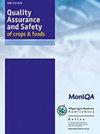传统和节能欧姆萃取法处理菠萝废弃物:潜在有毒元素和霉菌毒素污染
IF 5.3
3区 农林科学
Q1 FOOD SCIENCE & TECHNOLOGY
引用次数: 2
摘要
菠萝皮是一种环境问题的食物浪费。它可以通过传统的和新兴的技术,如欧姆加热提取其生物活性化合物。然而,真菌毒素和重金属污染可能是这种增值过程的关注点。采用高效液相色谱(HPLC)和电感耦合等离子体质谱(ICP-MS)研究了传统加热和欧姆加热对菠萝皮提取物中黄曲霉毒素和金属离子的影响。分析了欧姆工艺的能耗和对环境的影响。结果表明,基于欧姆的增值系统降低了83%以上的能耗和温室气体排放,有助于实现净零排放和可持续发展目标(sdg)。黄曲霉毒素B1、B2、G1、G2均低于检出限(B1、G1: 0.2µg/kg;B2, G2: 0.1µg/kg)。然而,由于电化学反应和电极腐蚀,欧姆萃取液中含有较高浓度的Cr、Pb、Ni和Fe。尽管欧姆增值系统的能力,检查食物垃圾和危险化学品的增值产品和投资于耐用电极(例如,钛)是欧姆系统工业实施的考虑因素之一。本文章由计算机程序翻译,如有差异,请以英文原文为准。
Valorized pineapple waste by conventional and energy-saving ohmic extraction: potentially toxic elements and mycotoxin contamination
Pineapple peel is a food waste with environmental concerns. It can be valorized by extracting its bioactive compound through conventional and emerging technologies such as ohmic heating. However, mycotoxins and heavy metals contaminations could be concerns of such a valorization process. This study assessed the effects of conventional and ohmic heating on selected aflatoxins and metal ions in pineapple peel extract using high- performance liquid chromatography (HPLC) and inductively coupled plasma mass spectrometry (ICP-MS). Also, energy consumption and environmental impacts of the ohmic process were analyzed. According to the results, the ohmic-based valorization system reduced energy consumption and greenhouse gas emissions by more than 83%, contributing to net-zero and sustainable development goals (SDGs). Aflatoxins B1, B2, G1, and G2 were below the detection limit (B1, G1: 0.2µg/kg; B2, G2: 0.1µg/kg). However, ohmic extracts contained higher concentrations of Cr, Pb, Ni, and Fe because of electrochemical reactions and electrode corrosion. Despite the capability of ohmic valorization systems, inspecting food waste and valorized products for hazardous chemicals and investing in durable electrodes (e.g., titanium) are among the considerations for ohmic systems’ industrial implementation.
求助全文
通过发布文献求助,成功后即可免费获取论文全文。
去求助
来源期刊

Quality Assurance and Safety of Crops & Foods
FOOD SCIENCE & TECHNOLOGY-
CiteScore
4.60
自引率
7.50%
发文量
61
审稿时长
1 months
期刊介绍:
''Quality Assurance and Safety of Crops & Foods'' is an international peer-reviewed journal publishing research and review papers associated with the quality and safety of food and food sources including cereals, grains, oilseeds, fruits, root crops and animal sources. It targets both primary materials and their conversion to human foods. There is a strong focus on the development and application of new analytical tools and their potential for quality assessment, assurance, control and safety. The scope includes issues of risk assessment, traceability, authenticity, food security and socio-economic impacts. Manuscripts presenting novel data and information that are likely to significantly contribute to scientific knowledge in areas of food quality and safety will be considered.
''Quality Assurance and Safety of Crops & Foods'' provides a forum for all those working in the specialist field of food quality and safety to report on the progress and outcomes of their research.
 求助内容:
求助内容: 应助结果提醒方式:
应助结果提醒方式:


